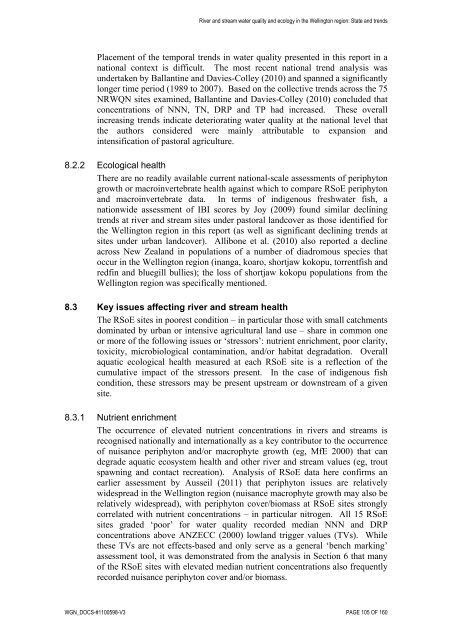River and stream water quality and ecology - Greater Wellington ...
River and stream water quality and ecology - Greater Wellington ...
River and stream water quality and ecology - Greater Wellington ...
Create successful ePaper yourself
Turn your PDF publications into a flip-book with our unique Google optimized e-Paper software.
<strong>River</strong> <strong>and</strong> <strong>stream</strong> <strong>water</strong> <strong>quality</strong> <strong>and</strong> <strong>ecology</strong> in the <strong>Wellington</strong> region: State <strong>and</strong> trends<br />
Placement of the temporal trends in <strong>water</strong> <strong>quality</strong> presented in this report in a<br />
national context is difficult. The most recent national trend analysis was<br />
undertaken by Ballantine <strong>and</strong> Davies-Colley (2010) <strong>and</strong> spanned a significantly<br />
longer time period (1989 to 2007). Based on the collective trends across the 75<br />
NRWQN sites examined, Ballantine <strong>and</strong> Davies-Colley (2010) concluded that<br />
concentrations of NNN, TN, DRP <strong>and</strong> TP had increased. These overall<br />
increasing trends indicate deteriorating <strong>water</strong> <strong>quality</strong> at the national level that<br />
the authors considered were mainly attributable to expansion <strong>and</strong><br />
intensification of pastoral agriculture.<br />
8.2.2 Ecological health<br />
There are no readily available current national-scale assessments of periphyton<br />
growth or macroinvertebrate health against which to compare RSoE periphyton<br />
<strong>and</strong> macroinvertebrate data. In terms of indigenous fresh<strong>water</strong> fish, a<br />
nationwide assessment of IBI scores by Joy (2009) found similar declining<br />
trends at river <strong>and</strong> <strong>stream</strong> sites under pastoral l<strong>and</strong>cover as those identified for<br />
the <strong>Wellington</strong> region in this report (as well as significant declining trends at<br />
sites under urban l<strong>and</strong>cover). Allibone et al. (2010) also reported a decline<br />
across New Zeal<strong>and</strong> in populations of a number of diadromous species that<br />
occur in the <strong>Wellington</strong> region (inanga, koaro, shortjaw kokopu, torrentfish <strong>and</strong><br />
redfin <strong>and</strong> bluegill bullies); the loss of shortjaw kokopu populations from the<br />
<strong>Wellington</strong> region was specifically mentioned.<br />
8.3 Key issues affecting river <strong>and</strong> <strong>stream</strong> health<br />
The RSoE sites in poorest condition – in particular those with small catchments<br />
dominated by urban or intensive agricultural l<strong>and</strong> use – share in common one<br />
or more of the following issues or ‘stressors’: nutrient enrichment, poor clarity,<br />
toxicity, microbiological contamination, <strong>and</strong>/or habitat degradation. Overall<br />
aquatic ecological health measured at each RSoE site is a reflection of the<br />
cumulative impact of the stressors present. In the case of indigenous fish<br />
condition, these stressors may be present up<strong>stream</strong> or down<strong>stream</strong> of a given<br />
site.<br />
8.3.1 Nutrient enrichment<br />
The occurrence of elevated nutrient concentrations in rivers <strong>and</strong> <strong>stream</strong>s is<br />
recognised nationally <strong>and</strong> internationally as a key contributor to the occurrence<br />
of nuisance periphyton <strong>and</strong>/or macrophyte growth (eg, MfE 2000) that can<br />
degrade aquatic ecosystem health <strong>and</strong> other river <strong>and</strong> <strong>stream</strong> values (eg, trout<br />
spawning <strong>and</strong> contact recreation). Analysis of RSoE data here confirms an<br />
earlier assessment by Ausseil (2011) that periphyton issues are relatively<br />
widespread in the <strong>Wellington</strong> region (nuisance macrophyte growth may also be<br />
relatively widespread), with periphyton cover/biomass at RSoE sites strongly<br />
correlated with nutrient concentrations – in particular nitrogen. All 15 RSoE<br />
sites graded ‘poor’ for <strong>water</strong> <strong>quality</strong> recorded median NNN <strong>and</strong> DRP<br />
concentrations above ANZECC (2000) lowl<strong>and</strong> trigger values (TVs). While<br />
these TVs are not effects-based <strong>and</strong> only serve as a general ‘bench marking’<br />
assessment tool, it was demonstrated from the analysis in Section 6 that many<br />
of the RSoE sites with elevated median nutrient concentrations also frequently<br />
recorded nuisance periphyton cover <strong>and</strong>/or biomass.<br />
WGN_DOCS-#1100598-V3 PAGE 105 OF 160
















